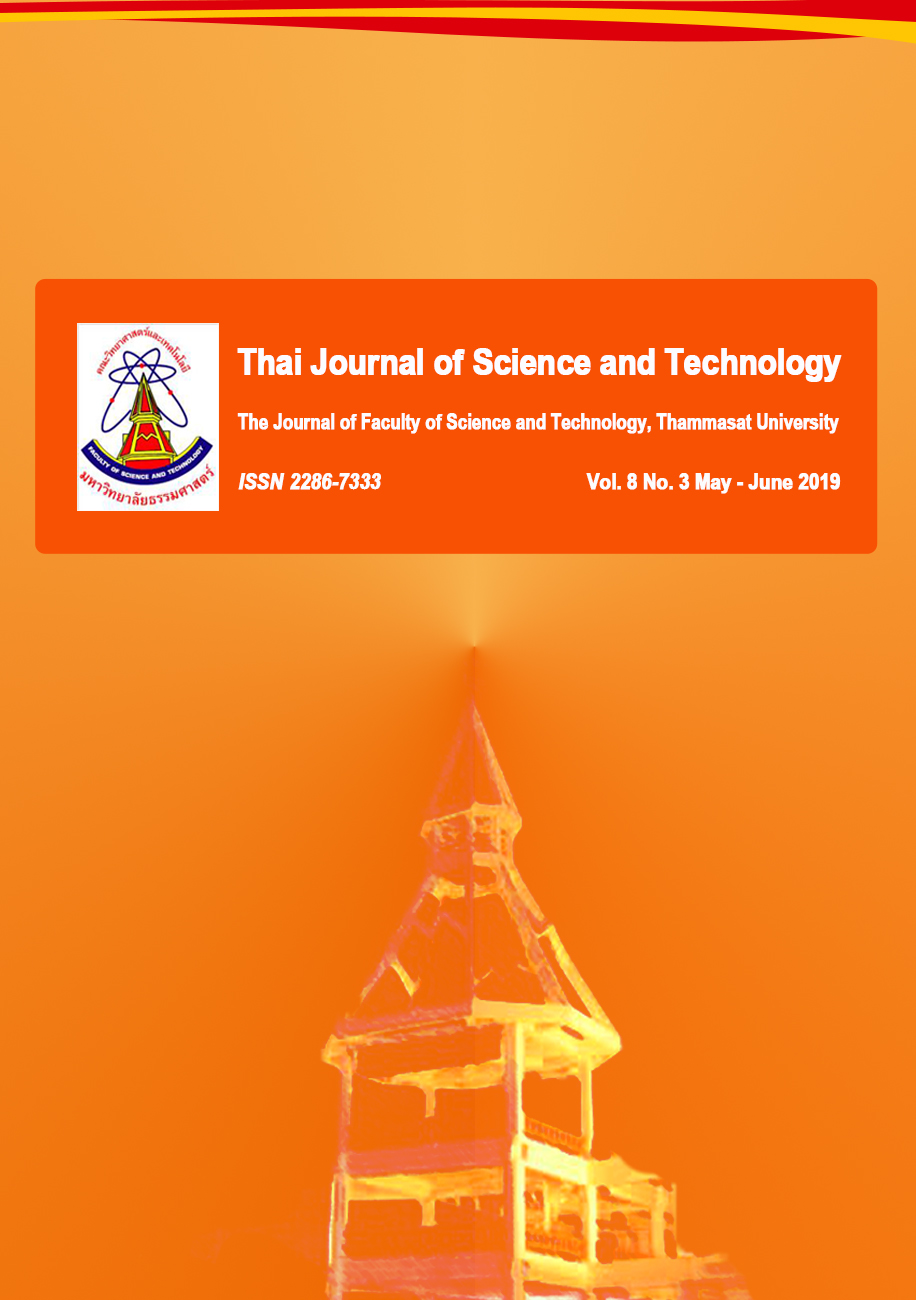การประยุกต์ใช้เครื่องหมายไอเอสเอสอาร์เพื่อตรวจสอบการเป็นลูกผสมข้ามชนิดระหว่างปทุมมาและกระเจียว
Main Article Content
Abstract
Abstract
Siam tulip, belonging to the family Zingiberaceae; genus Curcuma, is one of the economically important flowers in Thailand. To create novel hybrids attracting market demands, interspecific hybrids crossed between Siam tulip and its related species have been generated through sophisticated crossing techniques and embryo rescue. However, the hybridization process may create selfing or induce somatic embryogenesis. Hence, it is necessary to verify the true interspecific hybrids. The objective of this study was to apply inter-simple sequence repeat (ISSR) markers for detection of interspecific hybrids between Paracurcuma and Eucurcuma. The results of DNA amplification using 10 ISSR primers showed 72 amplified bands in total with 250-3,000 bp in size. Seventy-one amplified bands out of total (98.61 %) were polymorphic. Moreover, we also found that 9 primers (90 %) could be used for interspecific hybrid detection. A dendrogram based on polymorphic bands showed genetic similarities among parental species with similarity coefficients ranging between 0.04-0.57. In conclusion, the results in this study elucidated that ISSR markers were efficient to verify interspecific hybrids between Paracurcuma and Eucurcuma, which might be able to apply to other hybrids related to Curcuma sp. Furthermore, the genetic relationship shown in this study might be useful in the curcuma breeding program.
Keywords: Paracurcuma; Eucurcuma; interspecific hybrid; ISSR marker
Article Details
บทความที่ได้รับการตีพิมพ์เป็นลิขสิทธิ์ของคณะวิทยาศาสตร์และเทคโนโลยี มหาวิทยาลัยธรรมศาสตร์ ข้อความที่ปรากฏในแต่ละเรื่องของวารสารเล่มนี้เป็นเพียงความเห็นส่วนตัวของผู้เขียน ไม่มีความเกี่ยวข้องกับคณะวิทยาศาสตร์และเทคโนโลยี หรือคณาจารย์ท่านอื่นในมหาวิทยาลัยธรรมศาสตร์ ผู้เขียนต้องยืนยันว่าความรับผิดชอบต่อทุกข้อความที่นำเสนอไว้ในบทความของตน หากมีข้อผิดพลาดหรือความไม่ถูกต้องใด ๆ
References
ธีรนิติ พวงกฤษ, 2555, การศึกษาการปรับปรุงพันธุ์ปทุมมาโดยการผสมข้ามชนิดระหว่างพืชในกลุ่ม Eucurcuma และ Paracurcuma, วิทยานิพนธ์ปริญญาโท, มหาวิทยาลัยแม่โจ้, เชียงใหม่, 91 น.
ศิริพร พงศ์ศุภสมิทธิ์, 2547, การปรับปรุงพันธุ์พืช, นพบุรีการพิมพ์, เชียงใหม่, 253 น.
โสระยา ร่วมรังษี, 2558, สรีรวิทยา ไม้ดอกประเภทหัว, สำนักพิมพ์มหาวิทยาลัยเชียงใหม่, เชียงใหม่, 276 น.
สุรวิช วรรณไกรโรจน์, 2540, ปทุมมาและกระเจียว (Curcuma) ไม้ประดับ, สำนักพิมพ์บ้านและสวน, กรุงเทพฯ, 128 น.
สุรินทร์ ปิยะโชคณากุล, 2552, เครื่องหมายดีเอ็นเอ : จากพื้นฐานสู่การประยุกต์, สำนักพิมพ์มหาวิทยาลัยเกษตรศาสตร์, กรุงเทพฯ, 269 น.
Anuntalabhochai, S., Sitthiphrom, S., Thongtaksin, W., Sanguansermsri, M. and Cutler, R., 2007, Hybrid detection and characterization of Curcuma spp. using sequence characterized DNA markers, Sci. Hort. 111: 389-393.
Basha, S.D. and Sujatha, M., 2007, Inter and intra-population variability of Jatropha curcas (L.) characterized by RAPD and ISSR markers and development of population-specific SCAR markers, Euphytica 156: 375-386.
Chaveerach, A., Sudmoon, R., Tanee, T., Mokkamul, P., Sattayasai, N. and Sattayasai, J., 2008, Two new species of Curcuma (Zingiberaceae) used as cobra-bite antidotes, J. Syst. Evol. 46: 80-88.
Das, A., Kesari, V., Satyanarayana, V.M., Parida, A. and Rangan, L., 2011, Genetic relationship of Curcuma species from Northeast India using PCR-based markers, Mol. Biotechnol. 49: 65-76.
D'Hont, A., Rao, P.S., Feldmann, P., Grivet, L., Islam-Faridi, N., Taylor, P. and Glaszmann, J.C., 1995, Identification and characteri sation of sugarcane intergeneric hybrids, Saccharum officinarum x Erianthus arundinaceus, with molecular markers and DNA in situ hybridisation, Theor. Appl. Genet. 91: 320-326.
Hampl, V., Pavlícek, A. and Flegr, J., 2001, Construction and bootstrap analysis of DNA fingerprinting-based phylogenetic trees with a freeware program FreeTree: Application to trichomonad parasites, Int. J. Syst. Evol. Microbiol. 51: 731-735.
Mohanty, S., Joshi, R.K., Subudhi, E., Sahoo, S. and Nayak, S., 2012, Genetic stability assessment of micropropagated Mango Ginger (Curcuma amada Roxb.) through RAPD and ISSR markers, Res. J. Med. Plant 6: 529-536.
Page, R.D.M., 1996, TREEVIEW: An application to display phylogenetic trees on personal computers. Comput. Appl. Biosci. 12: 357-358.
Ruas, P.M., Ruas, C.F., Rampim, L., Carvalho, V.P., Ruas, E.A. and Sera, T., 2003, Genetic relationship in Coffea species and parentage determination of interspecific hybrids using ISSR (inter-simple sequence repeat) markers, Genet. Mol. Biol. 26: 319-327.
Saha, K., Sinha, R.K., Basak, S. and Sinha, S., 2016, ISSR fingerprinting to ascertain the genetic relationship of Curcuma sp. of Tripura, Amer. J. Plant Sci. 7: 259-266.
Singh, S., Panda, M.K. and Nayak, S., 2012, Evaluation of genetic diversity in turmeric (Curcuma longa L.) using RAPD and ISSR markers, Ind. Crops Prod. 37: 284-291.
Suwannoi, S., Kanchanaketu, T., Kusolkumbot, P., Sangduen, N. and Hongtrakul, V., 2012, DNA methylation and genetic study of interspecific hybridization in Jatropha curcas L., Thai J. Genet. 4(2): 94-105
Taheri, S., Abdullah, T., Abdullah, N. and Ahmad, Z., 2012, Genetic relationships among five varieties of Curcuma alismatifolia (Zingiberaceae) based on ISSR markers, Genet. Mol. Res. 11: 3069-3076.
Záveská, E., Fér, T., Šída, O., Krak, K., Marhold, K. and Leong-Škorničková, J. 2012, Phylogeny of Curcuma (Zingibera ceae) based on plastid and nuclear sequences: Proposal of the new subgenus Ecomata, Taxon 61: 747-763.


